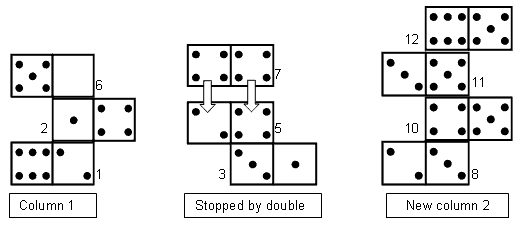Up-Down-Stop
Introduction
The idea behind this one player/solo/patience game of dominoes is to create something a little different that does not just rely upon the matching of tiles. That skill was covered in game called CrissCross - ChrisSmyth©2009
Equipment
The game was designed and tested using a double six domino set, but other sets can also be used.
An Overview
In this game the player creates columns of dominoes in which the number value of the domino is the important factor. Each domino is considered as two separate numbers one of which is considered active and is built upon either up or down. At any one time only two columns can be built upon. Doubles play a special role as they are used as stoppers to halt a column. The objective is to get all tiles in columns. Unusued tiles score one penalty point each, except for doubles, which do not count towards the score.
The Play
The dominoes are placed face down and shuffled to form the draw pile.
A domino is drawn and placed horizontally. The next domino is then selected and a decision made to either start another column or to place it in front of the first domino so that a column is created which will go either up or down (both columns can grow in the same or different directions). To do this the dominoes are placed offset and in a ladder formation. Play continues in this manner of selecting a domino, joining it to a column or if it cannot be played adding it face down to scrap pile. The blank is counted as zero and so the order of tiles is 3, 4, 5, 6, blank, 1, 2, 3... when going up, and 3, 2, 1, blank, 6, 5, 4... when going down.
If a double is chosen and if it matches the number at the top of a column then it is placed on top of that tile and the column is stopped. This means that the next tile drawn can, if it does not play on the other column, start a new column as two columns can always be in play. If the double cannot stop a column then it is discarded taking no further part in the game.
If the draw pile runs out then the scrap heap is shuffled and becomes the draw pile and the game continues. The scrap heap can be shuffled once only after which the number of tiles (except doubles) that are not in any column constitute the score.

Example Game
| Domino | Rationale |
|---|---|
| 1 | First tile starts a column |
| 2 | Tile could start the second column, but played on first tile, building down |
| 3 | Only place it can go is to start second column |
| 4 | 6/3 goes nowhere so played face down to scrap heap |
| 5 | Builds on column two, could be either way but to build up preferred - more options |
| 6 | Column 1, as a blank follows a 1 when building down |
| 7 | 4/4, as there is a 4 on top of column 2, it stops the column. (ie must be played on top of tile 5). |
| 8 | Only place to play is a start the second column again |
| 9 | 6/6 cannot stop either column so discarded |
| 10 | Builds on column2 |
| 11 | Builds on column2 |
| 12 | Could build on either column as a 6 follows a blank when going down (and vice versa) |
Scoring
The number of remaining tiles is the score - the aim is to score zero. Discarded doubles do not count towards the final score.
Comments & Strategy
The game has a nice feel and plays well. It can be played with a great deal of thought (so giving it a higher skill factor) or on a more superficial level
As for strategy, possibly counting dominoes may be useful, but thought about placing the dominoes to keep options open seems more a useful tactic.
Variations
- Try just one column or allowing three maximum.
- Try allowing scrap pile to be shuffled more than once.
- Try building both ways on the initial tiles
Try CrissCross and The Seven Pis (π). Any comments, suggestions or improvements please email
ChrisSmyth©2009